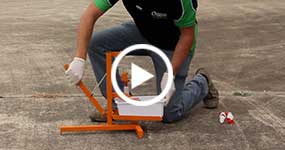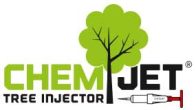What Can I Treat
Economical, efficient and refillable to control plant diseases by injecting trees
The Chemjet Tree Injector is the cost efficient tool to inject:- pesticides, fungicides, compounds which boosts the plants natural defence mechanism, fertilizers and trace elements. The true benefit of injecting the tree lies in utilising the trees natural circulatory system for transportation of the chemical. The following is a list of diseases that have been successfully managed and treated with Chemjet Tree Injectors. Ongoing research is being conducted around the world to further this list, for example the ongoing fight to remove the Coffee Berry Borer in ferrel coffee trees in Hawaii.
Avocado Root Rot
Phytophthora cinnamomi
Phytophthora cinnamomi is a soil-borne water mould which produces an infection in Avocado trees, better known as Root rot. This pathogen is the leading cause of damage to avocado trees worldwide, attacking the feeder roots causing them to become black and brittle and can kill or greatly debilitate trees. Root rot is largely dependent on the amount and intensity of rainfall, orchards can be wiped out by just one season of heavy rain.
Symptoms
In the early stages of the disease the first signs are retarded growth, discolouration and drooping of the tree canopy. The tree will produce excessive sets of small round fruit; the leaves will become small with brown tips and wilt during the heat of the day and may recover at night. Over time the foliage will become yellowish, shoots die back from the tips and eventually the tree is reduced to a bare framework of dying branches. Roots become dark, brittle and decayed. It may take months up to several years for the tree to die depending on soil characteristics, cultural practices and environmental conditions.
Management
Tree Injection has proven to be very effective in controlling and curing root rot. Tree injecting uses the trees natural transport system to distribute pesticides, fungicides and fertilizers to the areas where they are most effective providing immediate results, with no exposure to the environment. Phosphonate moves up the tree in the xylem and then down to the root system via the phloem. Phosphonate accumulated in the root system protects against invasion by Phytophthora cinnamomi.
Timing as to when to inject can make a difference. However for a very sick tree, one could argue that almost any time is a good time to inject. Recommended injecting times will vary from country to country depending on different phonological cycling. The recommended time to inject is when the spring and summer vegetative flushes have greened and hardened. It is recommended you do not prune back Avocado trees immediately before or after injecting as burning of new growth of shoots may occur. Do not inject Avocado trees in cold weather or during winter months, avoid trees where the trunk is damaged eg. Sunburnt and do not inject immediately above or below previous injection sites.

This avocado tree was suffering from Phytophthora (root rot). Note the brown tinge to the leaves. If left untreated this tree would die.

The same tree after treatment with phosphonate fungicide utilising the Chemjet Tree Injector.
Sudden Oak Death
Phytophthora ramorum is an oomycete plant pathogen which produces an infection in Oak trees, known as Sudden Oak Death. Sudden Oak Death has had devastating effects on oak populations in California and Oregon. Little is known of environmental factors in this disease. Primary inoculum (sporangia) produced on infected leaves is carried to new hosts via rain splash and air currents. There is a high risk of propagule transmission by humans who move infested plant material, logs and soil.
Symptoms
Sudden Oak Death is recognised by leaf infections; leaves can get irregular lesions and spots, older leaves become pale green and after a period of two to three weeks, foliage turns brown while clinging to the branches. In Coast Live Oaks and California Black Oaks the first symptom is a burgundy-red to tar-black thick sap bleeding from the bark surface. These cankers are the cause for the plants mortality which are diffuse and develop rapidly. The cankers may cause the bark of the tree to become discoloured, appear watersoaked and/or bleed dark liquid at the margins.
Management
On the larger forest scale it has been an enormous task to attempt to eradicate or treat Sudden Oak Death. However there are options for landowners who wish to treat or limit the impacts of the disease on their properties. Using the tree injector has proven to be very successful in limiting the effects of Sudden Oak Death. It is recommended to use a Potassium Phosphite and water solution injected into the trunk every 4” to 5” apart, uptake is relatively fast taking 5 to 45 min. Potassium Phosphite is lacking one oxygen molecule and is highly mobile in the trees, moving bi-directional.
- Oak Wilt
- Chestnut Blight
- Butternut Canker
- Emerald Ash Borer
- Apple Blight
Other Factors:
Injection under too great a pressure can lead to cell damage, uplifting of the bark which may impair the sap flow and may also force the tree to accept chemical when in fact it is not ready to absorb it. The Chemjet Tree Injection system is low pressure too avoid damage to trees. To determine the correct quantity and concentration of chemical, it is recommended to follow manufacturers guidelines and your local advisory service. As a rule, a tree requires one 20ml injection per 1 metre diameter of `canopy cover’. This probably only applies for avocado trees in eastern Australia.
Chemjet Tree injector has been successful for:
- Phytophthora, Root Rot, Trunk Cankers and Fruit Rots, in Fruit trees, Avocados and Durian.
- Conifer Canker. Silver Leaf in Apples and Pear Orchards.
- Armillaria, Root Rot in Kiwi fruit.
- Synopsis, Mango Blossom Malformation in Mangoes.
- Phytophthora, Stem Canker and Black Pod in Cocoa.
- Systemic Cultar Growth Regulator (Retardent) General.
- The Hairy Caterpillar.
How it Works

Ready to Order?

Success Stories?
Chemjet Tree Injectors is interested to hear from you, whether it be research or feedback from our growers. Send us an email or a post

